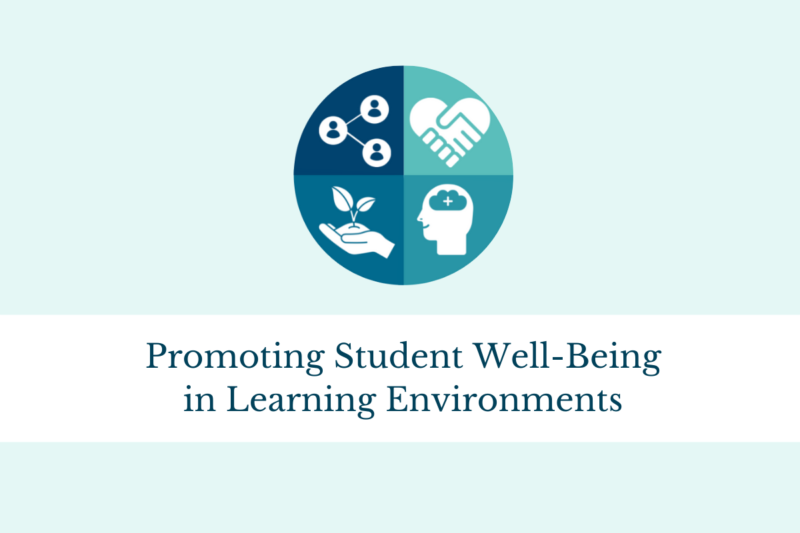
Faculty Spotlights: Compassion & Stress Reduction
WashU faculty share thoughts on being compassionate in their teaching.
 In the CTL’s new guidebook for instructors, Promoting Student Well-Being in Learning Environments, one of the keys to well-being that we highlight is Compassion & Stress Reduction. We encourage faculty to actively listen to students, acknowledge their perspectives, and use course policies and teaching practices that help reduce stress.
In the CTL’s new guidebook for instructors, Promoting Student Well-Being in Learning Environments, one of the keys to well-being that we highlight is Compassion & Stress Reduction. We encourage faculty to actively listen to students, acknowledge their perspectives, and use course policies and teaching practices that help reduce stress.
We spoke with three WashU instructors about how they are compassionate in their teaching and help to reduce student stress.
Nancy Reynolds
Associate Professor of History, of Women, Gender and Sexuality Studies, and of Jewish, Islamic, and Middle Eastern Studies
What are some ways that you are compassionate in your teaching?
“Even before the pandemic, I realized that student stress really gets in the way of learning. So I began to experiment with strategies that would help to address this. There are some things that I initially did for other pedagogical reasons, but that I’m finding turn out to be practices of compassion. As an example, I try to give students more agency and choice, because I feel like one of the things that happens is that students experience stress as a lack of agency, and so I give them some space for choice, both in how they engage in classroom experiences and how they time them.”
How do you balance structure and flexibility when designing course policies?
“I provide a ‘grace day’ for papers that every student can use one time in the semester and it allows them to take an extra day without penalty or prior permission. It helps students and it’s more efficient for me. I don’t receive so many emails the night before a deadline. So I think these things can be complementary: you can become a more efficient teacher, while you’re also being more compassionate to students. And if they ask me for an extension, I have them set a new deadline. I like that this asks students to learn to self-assess, and they usually set a deadline sooner than I would have given them.”
How do you talk with students about well-being and/or increase awareness of mental health resources on campus?
“Mental health is something really important to talk about in the classroom. It’s not my job to solve everything, but I don’t think it’s helpful to pretend that what happens in the class is cut off from the rest of what’s going on with students.
During class I will show students the page for mental health services and where they can go to make an appointment. And I’ll say that I know many people who have found these kinds of supports and resources helpful. I’ve also been experimenting with sending short notes to my students that I know are struggling. Something like, ‘No need to respond, just thinking about you and hoping that you’re having a better week this week.’”
Mairin Hynes
Senior Lecturer in Physics
What are some ways that you are compassionate in your teaching?
“Something that I’ve learned over time and especially during the pandemic is how important it is to be accepting of whatever a student is facing that is important to them. Just because something wouldn’t be a significant issue for me or wouldn’t impact me directly, it doesn’t mean that the student’s experience is less valid. I think students for the most part are really honest so I try to take what they say and realize that’s important to them.”
How do you balance structure and flexibility when designing course policies?
“For all of our assignments we have some drops built in, and students don’t need to say why they’re using it, it’s just automatic. I think this is helpful because students might need flexibility for all kinds of reasons and students might not feel comfortable sharing the reason why they didn’t do something.
And we’ve also thought hard about how to frame policies in the syllabus to help students feel we are approachable. The syllabus language used to be very formal and had almost a tone of ‘there are built-in drops so that you won’t bother us about things.’ Now we’ve changed to more positive language—how we understand that things happen and we want students to know the drops are there if they need them because we care about them and their learning.”
Click here for an example of positively framed syllabus language.
How do you talk with students about well-being and/or increase awareness of mental health resources on campus?
“From talking with students I know that they feel that mental health still has a big stigma on campus and that people are more sympathetic about physical health, and are more likely to have a ‘just suck it up’ attitude toward mental health. So I let students know that I understand that both mental and physical health struggles happen and you don’t choose them. I also mention mental health resources available on campus. For instance, I let them know it doesn’t have to be a formal appointment, there are drop-in options like Let’s Talk too.”
Eliza Williamson
Lecturer in Latin American Studies and Romance Languages & Literatures
What are some ways that you are compassionate in your teaching?
“It’s hard to pull back from a ‘tough luck’ kind of attitude with hard deadlines and policing students because it was so ingrained in my own education. For example, if I’m asked for a deadline extension, sometimes my first instinct is that maybe the student is just trying to blow off this class. But what I do is try to distance myself from that feeling and give students the benefit of the doubt. It’s difficult, but it’s also freeing for me because I don’t have to feel like I need to keep tabs on students.
And sometimes people make it seem like we can either be compassionate teachers or we can prepare our students for the world outside of academia. I don’t believe that it’s a dichotomy. I don’t believe that those things are opposite from each other. I do believe that we’re preparing students for going out beyond the university. And from a social justice approach to teaching, I’m not just preparing students to live and work in the world, but to also help to transform that world in positive ways. It’s not just through the subject matter I teach that I can do that. It’s also through the environment that I build in class.”
Are there things you do in your class to help reduce student stress?
“Toward the beginning of the course, there’s a mindfulness meditation where we focus on different parts of the body and just sitting, breathing, and feeling our breath. This exercise has a pedagogical purpose in my class, but it also has a calming effect during those first intense weeks of the semester. I’ve received a lot of positive feedback from students on that activity and students have asked if we can do another meditation. And even though there’s a lot we need to do during class, I feel like that can be worked in different ways. For instance, when students read something or listen to discussion, having them focus on how their body reacts to that and identify the feeling.”
This post is part of our ongoing series on Promoting Student Well-Being in Learning Environments, check out our News page for more posts in the series.





